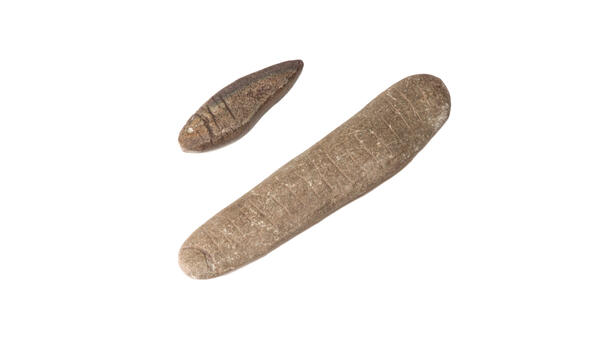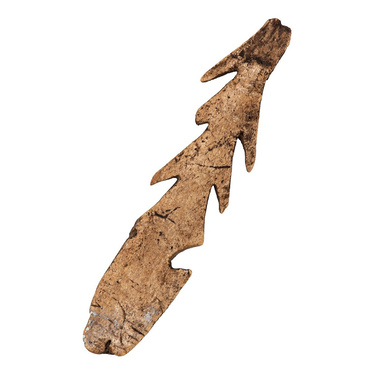During excavations at Neolithic sites, archaeologists would often find art objects, including small sculptures shaped like real and imaginary animals. They were made out of stone, bone, horn, or clay. Researchers speculated that these items may have been used as cult objects, jewelry, charms, fishing gear, or simply children’s toys.
The ancient masters of Siberia recreated in the figures images of animals that lived around: moose, bears, seals, birds. One of the most common options was fish — it was associated with the important role of fishing. In the Holocene epoch, about 12,000 years ago, global climate changes began, due to which large representatives of fauna disappeared: mammoths and woolly rhinoceroses. As a result, early humans had fewer sources of food and had to look for other ways of living — so fishing spread. At the same time ancient people began to make bone harpoons, hooks and stone sinkers.
The elongated sculpture from the collection of the Irkutsk Museum of Local History was found in 1949 by archaeologist Pavel Khoroshikh. He participated in excavations at ancient sites on the right bank of the Angara River, near the village of Shchukina. It was destroyed when the Irkutsk Hydroelectric Power Plant was built there.
The exact purpose of this “stone fish” is still unknown. Figurines with a hole could be used as baits for fishing. But, most likely, such objects were associated with religious cults: they were often found in burial sites. Some researchers have suggested that the fish figures were amulets: it was believed that fish represents procreation, and caviar symbolizes a large number of offspring.
Ancient objects that have no obvious economic purpose, including images of fish, are generally considered to be examples of prehistoric art. Even if the sculptures were a technical device and had no symbolic meaning, they were a result of creative activity and provide an opportunity to reflect on the worldview and spiritual culture of the indigenous population of Siberia.
The ancient masters of Siberia recreated in the figures images of animals that lived around: moose, bears, seals, birds. One of the most common options was fish — it was associated with the important role of fishing. In the Holocene epoch, about 12,000 years ago, global climate changes began, due to which large representatives of fauna disappeared: mammoths and woolly rhinoceroses. As a result, early humans had fewer sources of food and had to look for other ways of living — so fishing spread. At the same time ancient people began to make bone harpoons, hooks and stone sinkers.
The elongated sculpture from the collection of the Irkutsk Museum of Local History was found in 1949 by archaeologist Pavel Khoroshikh. He participated in excavations at ancient sites on the right bank of the Angara River, near the village of Shchukina. It was destroyed when the Irkutsk Hydroelectric Power Plant was built there.
The exact purpose of this “stone fish” is still unknown. Figurines with a hole could be used as baits for fishing. But, most likely, such objects were associated with religious cults: they were often found in burial sites. Some researchers have suggested that the fish figures were amulets: it was believed that fish represents procreation, and caviar symbolizes a large number of offspring.
Ancient objects that have no obvious economic purpose, including images of fish, are generally considered to be examples of prehistoric art. Even if the sculptures were a technical device and had no symbolic meaning, they were a result of creative activity and provide an opportunity to reflect on the worldview and spiritual culture of the indigenous population of Siberia.



